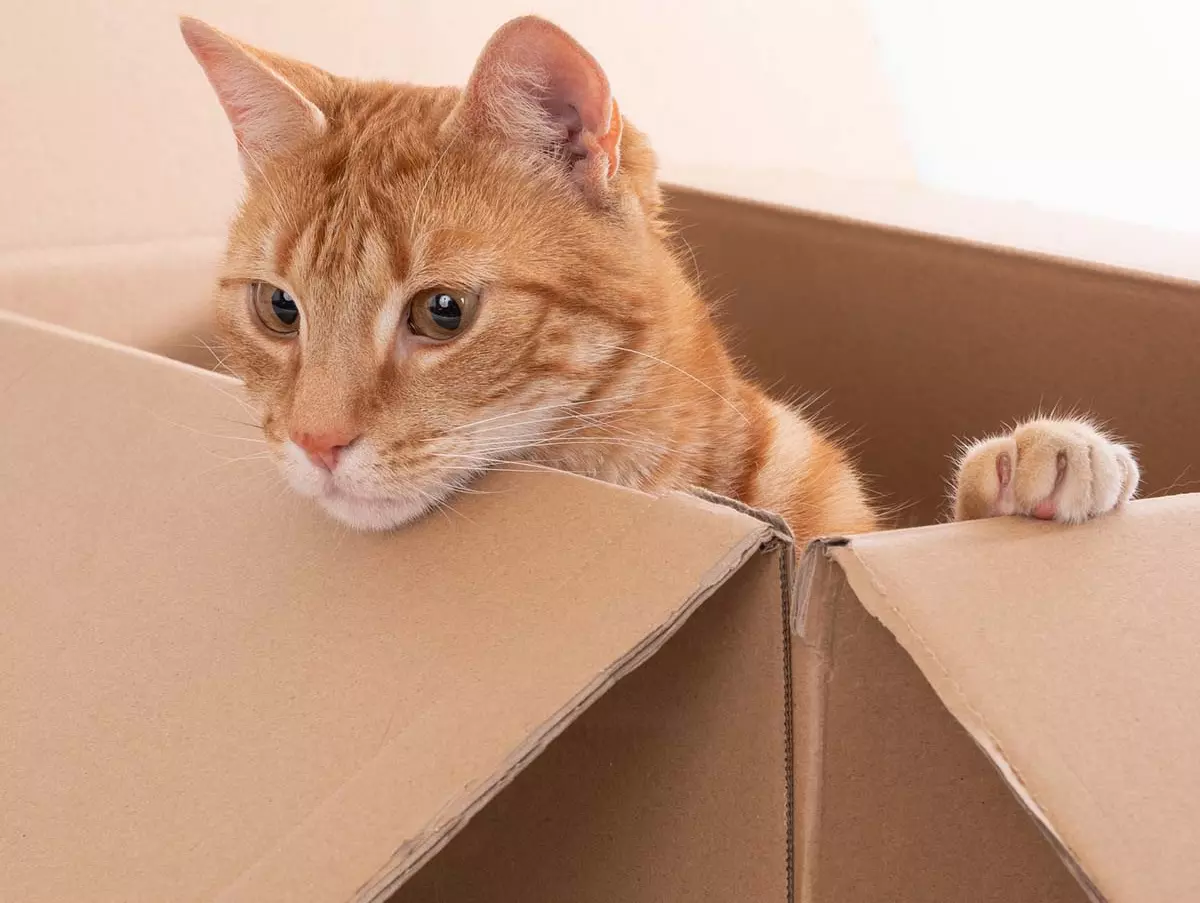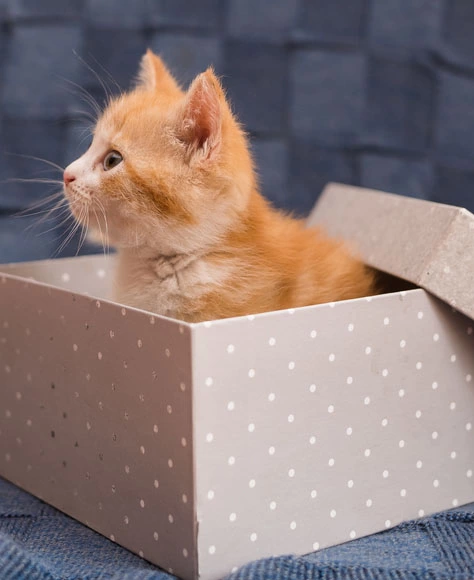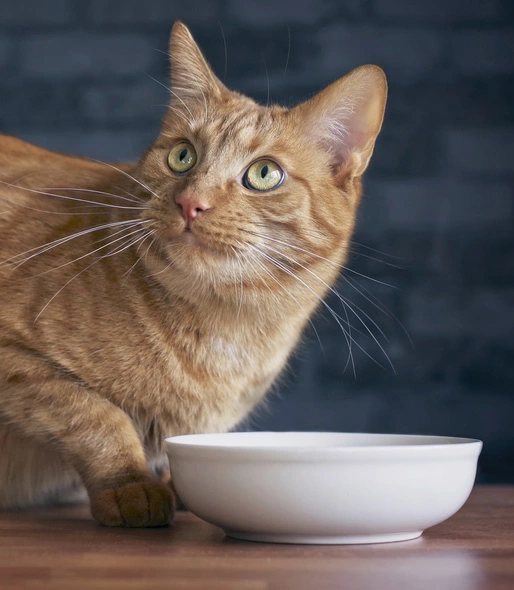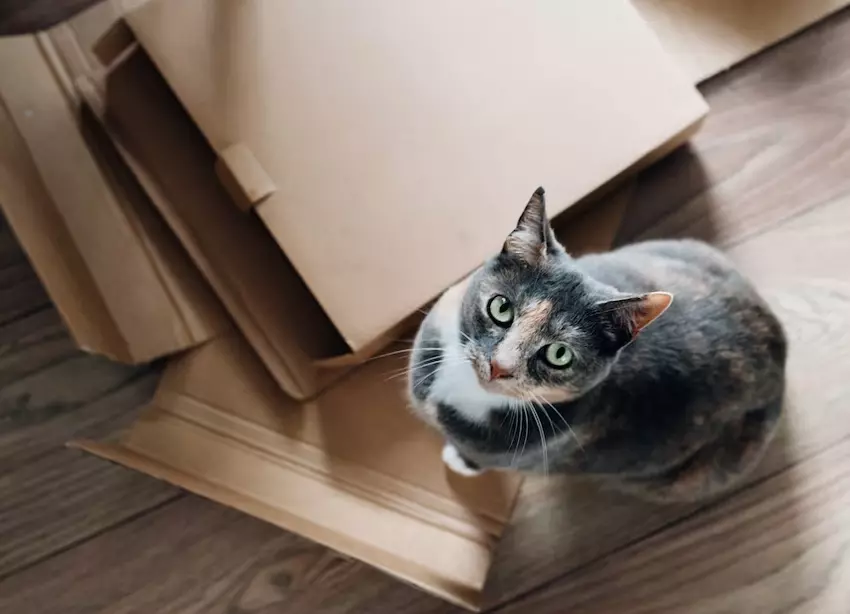Cat Not Eating After Move? Here’s The Reason Why
Moving is a stressful time for families, including their furry members. Our cats also bear the brunt of the change, which can lead to a cat not eating after a move.
This is a fairly common problem among pets, especially if they aren’t desensitized or prepared for the relocation. But with extra care and the right approach, your feline friend will regain their appetite in just a few days.

In this post, I share my personal tips as a long-time cat owner. Read on to see how you can support your cat during a move and how to reduce its stress during a move.
Is it normal for a cat not to eat after moving?
It’s quite common for cats to stop eating after a move. While it’s normal for cats to have eating problems when moving, it’s important to boost their appetite to avoid potential health issues.

So why does it happen? Here are a few reasons why:
1. Stress is to blame
If you’re stressed during a move, so is your cat. Felines are beings of habit, so a change as massive as relocating to a new place can throw off their routines.
This experience is extremely stressful since cats are very cautious with their environment. Some are also very territorial, and whisking them away from their established territory is extremely disruptive.
Aside from that, a new place also means new scents and sights. This sense of unfamiliarity will scare your cat, which will negatively impact its appetite.
2. Your cat is feeling unsafe.
Your cat may refuse to eat if it senses danger in your new place. This insecurity can also lead to behavioral problems if not addressed right away.
The presence of another pet can trigger this problem, as well as new scents, sights, and sounds. All these new stimuli are overwhelming for a cat, which will disrupt its regular routines.
This unsafe feeling will worsen if your cat is often left alone in the new house as you try to settle the relocation. With this, moving is the best time to give your kitty extra love, so they won’t feel left out during the process. Please read here: How Long Can You Leave A Cat Alone at Home
3. Your cat is experiencing separation anxiety.
Another reason your cat isn’t eating is that it misses your old place. This is especially true if you move out and leave behind family members.
Since your cat is used to having these people around, moving away will cause separation anxiety. Aside from poor appetite, your cat may try to escape and go back to your old home.
Also, your cat will exhibit other symptoms of separation anxiety, including excessive meowing, destructive behavior, and intense self-grooming. If not addressed, separation anxiety will become a bigger behavioral issue.
4. Your cat is in the adjustment period.
In most cases, cats will start eating a few days after your move. You just have to give them time to adjust to their new environment.
During this adjustment period, giving your cat extra care and attention is crucial. Try to resume their mealtimes and other routines as you would in your old home.
Also, don’t punish your cat for behaving differently or refusing to eat after your move. Be patient, and remember that your little furry friend just needs a little more time to settle.
Signs your cat is stressed during a move
Aside from poor appetite, there are many signs that your kitty is stressed during or after a move. By knowing these symptoms, you can help your cat relax and adjust to its new home.

Here are the tell-tale signs that your cat is stressed:
- Hiding. For cats, being brought to a new home is like being shoved into a scary cave. This is why your cat will try to hide to seek a quieter and smaller space, much like they do in the wild.
- Increased vocalization. Excessive meowing and howling are hallmark signs of a distressed cat.
- Aggression. Even the friendliest cat can show signs of aggression if they are placed in a very stressful situation. This is the same for your pet after moving, where everything is new to them.
- Intense grooming. Excessive grooming can be a cat’s way to release tension and anxiety. This can cause bald patches as the cat aggressively chews, licks, and grooms its body.
- Accidents around the house. If your litter-trained cat urinates or defecates outside the box, it’s experiencing stress. Take note that some cats will also ‘mark’ with their urine, especially male ones.
How long does it take a cat to adjust after moving?
Each cat is different, and so is its response to moving. Some felines won’t have problems settling into a new place, while others may take weeks to adjust.
The key here is taking your cat’s lead during the adjustment period. Let them hide at first and slowly introduce positive reinforcements to help them overcome stress.
Never pull your cat out of its hiding place because this will just make the experience of relocating more stressful.
Overall, give your cats a few weeks to adapt. Much like it takes us time to explore a new neighborhood, our cats will also need enough time to get used to their new place.
But as your cat adjusts, make sure that all windows, doors, and other exit points are shut. Almost every cat will try to escape their new home to return to their old place.
How do I get my cat to eat in a new place?
If your cat doesn’t want to eat after moving, there are some workarounds you can try. You can also call your pet’s veterinarian to seek proper advice if all these don’t pan out well.

For our cat Watson, the following tips worked:
1. Make mealtimes rewarding
One way to encourage your cat to eat is to provide rewards during mealtimes. You can bring a new toy or sprinkle its meal with tasty treats.
Aside from that, you can also pet and talk to your cat to help it calm down. This can help encourage your pet to accept food slowly.
2. Feed in a safe space.
Cats tend to be scared of massive unfamiliar spaces. So if you are to feed the kitty, choose a small corner where it will feel safe.
It’s also a good idea to feed your cat right next to its bed in the meantime. This way, your pet won’t have to walk through unfamiliar areas in your new home.
3. Give them some company.
For some cats, it helps when their owners accompany them during mealtimes. This will give your pet a sense of security since you’re around to watch over them.
4. Use calming aids
Since poor appetite is often triggered by moving-related stress, calming aids can significantly help your cat.
You can buy artificial pheromones, which are diffused in a room. These are odorless to humans, but it mimics the scent mother cats release, which is calming for felines. Read more here: Why Does Mother Cat Move Only One Kitten
If your cat tends to be anxious after moving, calming treats will come in handy. You can feed this to your cat to prepare them for mealtimes.
5. Opt for softer food
As your cat tries to adjust, it’s best to stick to mushy and soupy food. These are easier to eat and digest since stressed cats tend to have upset tummies.
Aside from that, soupy food provides your cat with nourishment and hydration. This will be a great strategy if your kitty is also refusing to drink.
How long can a new cat go without eating?
New cats that are brought to their new homes usually exhibit poor appetite. This is mainly due to stress, especially if the kitty has stayed in a kennel for long periods.
On average, a cat can go without eating for about a week, but it doesn’t mean it’s safe to let them do this. In fact, a day without food is enough to cause life-threatening hypoglycemia in small cat breeds.
Also, cats with underlying health problems may easily succumb to death if not fed for hours.
This is why it’s essential to encourage your cat to eat, even in small amounts, while adjusting to a new home.
Are cats traumatized by moving?
Cats can get traumatized by moving, especially if they aren’t prepared or cared for, such a big change. Remember that a cat’s life is centered on familiarity and routines, so disrupting this cycle will have a negative impact on its behavior.
The good news is that there are easy ways to avoid this problem. Desensitizing your cat to small changes leading up to the move day can make a big difference.
The key here is keeping your pet in mind while planning your move. If you’re welcoming a new cat into your home, ensure you’re prepared for the adjustment period.
Additional tips to help your cat adjust after moving
Moving is a big change, and your pets may not take it easy. If you have a cat, here are the steps you can take to ensure that they will settle quickly in your new place:

1. Introduce one room at a time
When bringing your cat to your new place, it’s best to choose one small room where it will stay. Allow the kitty to get used to this small room first before letting it roam around the house.
This way, moving to your new place will be less overwhelming. Still, make sure that the windows are closed to prevent any escape attempts.
2. Make your cat’s room comfortable.
To help your cat adjust, you should make the space as comfortable as possible. Start by placing a comfy bed with your pet’s favorite toys.
Aside from that, place a litter box across the room, so your kitty can eliminate whenever it needs to. A clean bowl of food and water is also needed. Please read here: Why Does My Cat Sleep In The Litter Box
3. Limit visitors
Moving is an overwhelming experience for cats, especially if they are crowded with visitors. So while your kitty adjusts, don’t force them to meet guests.
Let your kitty approach people on their own terms. If your pet runs and hides, let it be.
4. Spread your cat’s scent.
Before you move your cat, it helps to spread its scent in your new home. Get a soft cloth and rub it gently on your cat’s cheeks where scent glands are located.
After that, take this cloth to your new home and rub it on walls, doorways, and furniture. Do this on areas within your cat’s height and reach.
This way, your cat will pick up its own scent in the new home, which will help it settle in faster.
5. Provide small but frequent meals.
Instead of forcing your cat to eat full meals, offer small portions multiple times daily. From two full meals, you can switch to four or five portions until the kitty has fully adjusted to the new home.
This way, eating won’t be a stressful experience, and your cat will still get proper nutrition despite its poor appetite.
6. Keep your cat occupied.
Games and toys help keep your cat’s mind off the stress while moving. It’s also a good way to associate your new home with a positive experience.
If you have another pet that goes along with your cat, allow them to play and spend time. This will ease the anxiety your cat is experiencing due to the sudden change.
7. Stick to a routine
Cats can adjust faster to a new home if you are consistent with their routines. This includes on-time feeding, evening snuggles, and scheduled playtime.
Try to stick with your chosen routine even as you juggle cleaning around, running errands, or sorting out boxes. Taking turns with family members is best to ensure your furry friend isn’t left behind.
Conclusion
Moving is challenging, especially if you have a cat in tow. You also have to prepare the kitty for the big change so that it will settle in faster.
Also, expect that your pet will have appetite problems due to stress. Be patient and try to offer small meals slowly.
If all else fails, you should consult a veterinarian for a different approach. You can also talk with an animal behaviorist to figure out the best approach to your cat’s eating problem.
